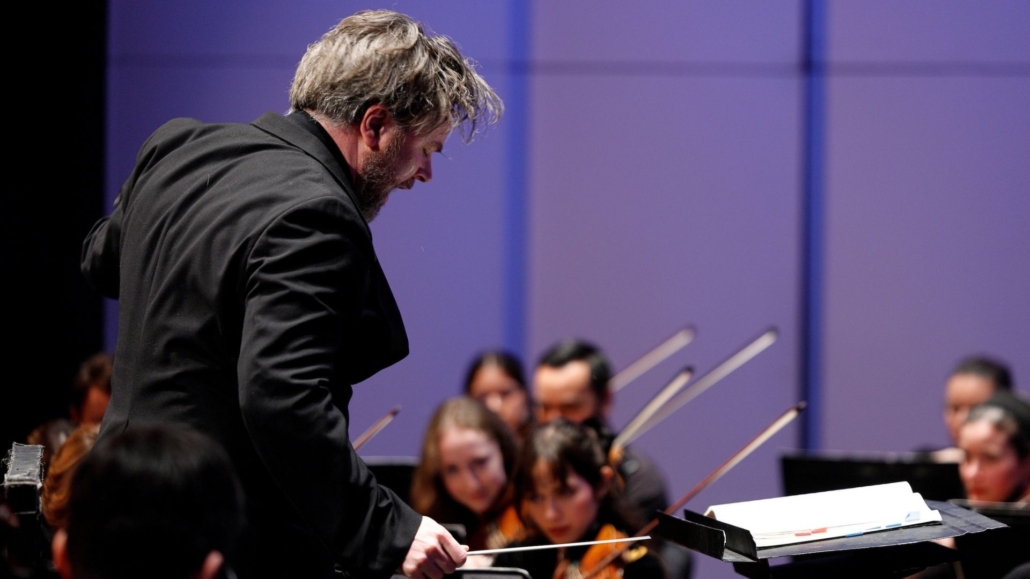In the symphonic pantheon Gustav Mahler is unquestionably a god, seated at Ludwig van Beethoven’s right hand and illuminated by the golden glow of his own personal halo. But are gods approachable? Are their ways not mysterious to man? We have to respect Mahler, but do we have to love him?
No, says Victoria Symphony music director Christian Kluxen. But if we enter Mahler’s world with an open mind, he adds, we will.
“His music can feel intimidating at first: it’s long, it’s dramatic, and it’s full of extremes,” the conductor explains, in his comments on Mahler’s Symphony No. 5, which concludes the orchestra’s 2025-26 season. “And, yes, it often gets talked about in ways that are almost religious, which doesn’t always help. But underneath all of that is something incredibly human, and deeply accessible—if you approach it the right way.”
There are, admittedly, a number of wrong ways that are tempting to follow. Do not, for instance, take Thomas Mann’s novella Death in Venice as the gospel truth. Yes, it incorporates elements of Mahler’s last few weeks, which were spent in the waterfront city, and Mann’s description of his central character, a writer named Gustav von Aschenbach, draws on the ailing composer’s real-life appearance. But von Aschenbach’s inner life is a compendium of non-Mahlerian sources, including Mann’s own repressed bisexuality, elements of the elderly Johann Wolfgang von Goethe’s heterosexual feelings for the much younger Baroness Ulrike von Levetzow, and enough arcane literary references to launch a thousand theses. As a Mahler “biographer”, Mann is a most unreliable narrator.
Luchino Visconti, whose 1971 film adaptation of Mann’s book remains a classic of historical drama, offers another dead end to the aspiring Mahler scholar. Visconti plays up the Mahler connection by making von Aschenbach a composer, not an author, and by making liberal use of excerpts from Mahler’s Third and Fifth symphonies in his score. Cineasts of a certain age will certainly experience flashbacks when Kluxen and the VS reach the Fifth’s fourth movement, the glorious “Adagietto”. But, again, however beautiful Visconti’s Death in Venice might be, it is emotionally gripping fiction, not accurate reportage.
Kluxen suggests that listeners undergo a kind of memory-purge before entering the Royal Theatre to hear the Symphony No. 5. “Forget the big symbol, the legacy, the shelf full of books,” he says. “Just listen to what it actually does, because this piece is a journey. Not a narrative, not a program, but a kind of emotional topography. A landscape. And once you’re in it, you don’t have to understand it—you just have to feel where it takes you.”
Should that prove difficult, Kluxen goes on to provide a hand-drawn map of Mahler’s terrain, speckled with useful annotations.
“Mahler 5 starts with a funeral march, but not in the grand or noble sense,” he begins. “It’s private. It’s raw, awkward even. The trumpet solo that opens the piece doesn’t feel like a clean fanfare—it’s cracked, slightly unstable. And then the music collapses into this wave of struggle and conflict. The first movement is full of tension: it surges, hesitates, claws its way forward. And the second movement feels like the same energy boiling over—more violent, more chaotic. Mahler called it a kind of ‘screaming’, a purging of pain. So already, in the first half of the symphony, you’re dealing with something very real: not an idea of death, but the experience of it. Something personal and unresolved.
“But then, right in the middle of all this intensity, you get the ‘Scherzo’, and the world flips upside down. Suddenly it’s Viennese, rustic, awkwardly joyful. It dances, but it’s clumsy, full of strange accents and little traps. It’s not a release of tension, but it opens the door to a different world. And that’s important, because it’s in this strange middle ground that the music starts to recover.”
In this context, he continues, the “Adagietto” is not the tragic lament of Visconti’s film, but something much more tender.
“It’s a love song,” Kluxen stresses, pointing out that at the time of the Symphony No. 5’s composition Mahler was still in the honeymoon phase of his turbulent marriage to Alma Schindler, and as besotted as a deeply analytical man could be. “It’s the only part of the symphony that doesn’t have full orchestra: just strings and harp,” he says. “It’s stripped down, full of breath and space. Not a monument, but a confession.
“And then comes the finale, and it’s like the clouds break. Suddenly everything is light and motion and counterpoint and joy. But not superficial joy—it’s joy earned after pain. And it’s not naive either. Mahler doesn’t wrap things up with a bow—he pushes the orchestra harder and harder, testing if this joy can actually hold. And in the end, it does. It really does.”
There are no easy explanations for this resolution, Kluxen admits. “The Fifth Symphony is big and messy and full of contradictions,” he notes. “But what I love about it is that it doesn’t offer one idea or one truth. It’s just Mahler trying to work out life through sound, as he always does. And it’s something we all do, in our own way; we try to make sense of joy and loss, of beauty and fear, of the past and the future. Mahler just happens to do it on a very large and very detailed scale.
And for me, that’s why this symphony felt like the right way to end our season,” he concludes. “Not just because it’s impressive, which it is, but because it leaves you somewhere new. Somewhere fragile and alive and still unresolved. It’s not a victory lap—it’s a question, a breath, a kind of human echo. And for our 85th anniversary season, that felt especially meaningful. Not to look back and close a chapter, but to look forward. To finish with a piece that is full of doubt and beauty and transformation, because that’s what any living orchestra should be: always searching, always reaching, always becoming something more.”
Notes by Alex Varty



 Christian Kluxen, conductor
Christian Kluxen, conductor